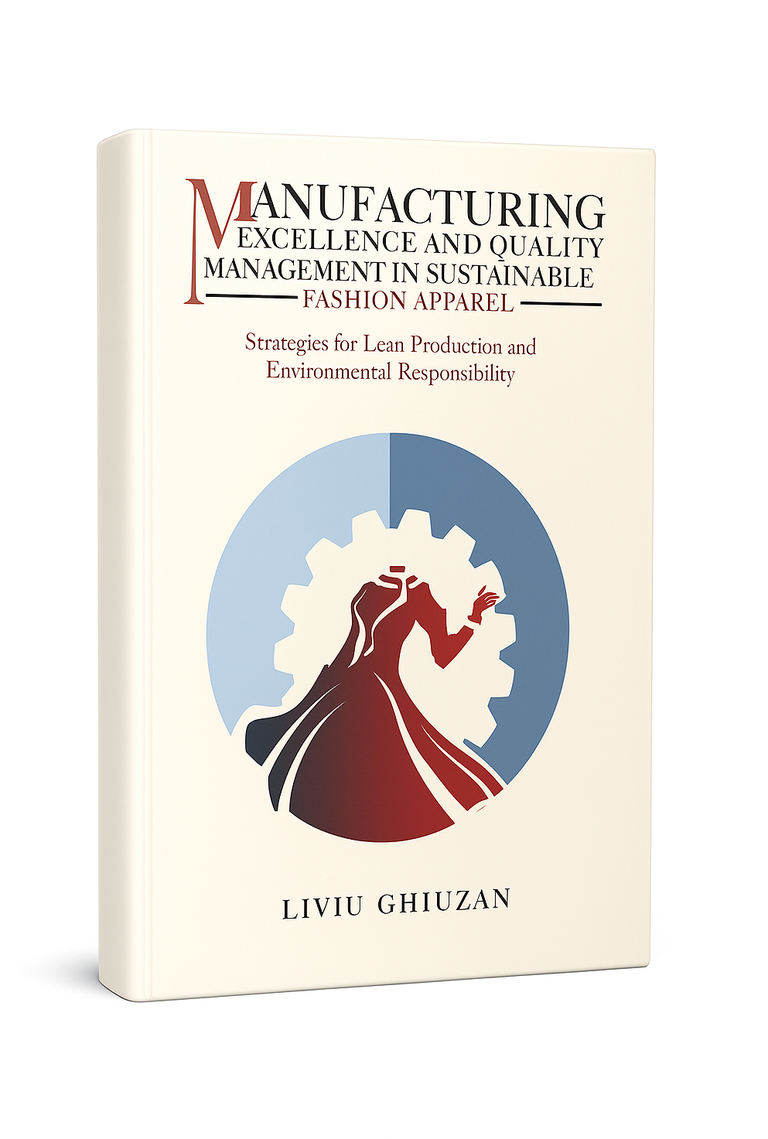Manufacturing Excellence and Quality Management in Sustainable Fashion Apparel: Strategies for Lean Production and Environmental Responsibility

A pragmatic end-to-end playbook for lean apparel production, QMS, SOPs, inspections, AQL, and sustainability in fashion manufacturing.
Manufacturing Excellence and Quality Management in Sustainable Fashion Apparel: Strategies for Lean Production and Environmental Responsibility is a pragmatic, end-to-end guide for leaders and practitioners in the apparel manufacturing and garment industry who need reliable methods to raise quality, increase efficiency, and embed sustainability. It connects lean production with Quality Management System (QMS) governance, Standard Operating Procedures (SOPs), and day-to-day garment quality control so teams can deliver consistent results across product development, cutting, sewing, and finishing.
You’ll learn how to structure sampling protocols, inline checks, final inspections, and Acceptance Quality Level (AQL) criteria; how to diagnose defects with root-cause analysis (RCA) and drive improvements through Corrective Actions and Preventive Actions (CAPA); and how to optimize factory layout, line balancing, and material flow for better first-pass yield (FPY) and on-time delivery. The book also covers ethical sourcing, supply-chain compliance, and environmental responsibility in sustainable fashion, including practical guidance for equipment care and sewing equipment calibration that supports repeatable quality.
Designed for production managers, quality & compliance specialists, sourcing teams, founders, and students, this reference bridges academic frameworks with real factory realities—turning policy, audits, and sustainability goals into measurable outcomes in clothing production.
What you’ll learn
- Reduce waste & defects with lean apparel production methods (cut-and-sew workflows)
- Develop Standard Operating Procedures (SOPs) that govern the full apparel lifecycle, ensuring consistency and audit-readiness
- Establish quality control protocols covering sampling, fabric testing, inline checks, final inspections, and Acceptance Quality Level (AQL) criteria
- Conduct structured quality audits to verify compliance, supplier performance, and long-term process reliability
- Build a resilient Quality Management System (QMS) aligned with recognized standards (ISO-style frameworks)
- Enhance first-pass yield (FPY) using root-cause analysis (RCA) and Corrective Actions and Preventive Actions (CAPA)
- Optimize factory layout, line balancing & material flow to boost throughput
- Integrate ethical sourcing and sustainable fashion practices into day-to-day operations
- Select, calibrate & maintain sewing equipment for consistent garment quality control
- Promote employee wellbeing through health and safety (H&S) programs, ergonomic design, and continuous training initiatives
Overview
This guide offers a comprehensive, practice-focused framework to elevate operational excellence in apparel manufacturing. It combines lean methodologies, Quality Management Systems, SOPs, and sustainability practices to drive quality, efficiency, and environmental responsibility—from product design to final shipment.
You’ll find structured pathways for sampling protocols, inspection criteria, and measurement plans; methods to diagnose bottlenecks and enable corrective action through RCA and CAPA; and approaches that improve inline and final inspections while linking supplier performance with compliance and sustainability goals.
Topics & Academic Relevance
Manufacturing Excellence and Quality Management in Sustainable Fashion Apparel examines how operational excellence, lean manufacturing, and sustainability principles intersect in the apparel sector. At the London College of Fashion, it is associated with subjects including the clothing trade, sustainable methods in apparel, lean manufacturing, and quality control—highlighting academic relevance across sustainability, supply chain management, and quality-driven business models.
Global Academic Reach
Beyond London College of Fashion, the author’s works are accessible through academic library networks used by leading universities worldwide, including MIT, ETH Zürich, The University of Hong Kong, Cornell University, EPFL Lausanne, McGill University, The Hong Kong Polytechnic University, and the University of Leeds, among others across the global top-100.
Frequently asked Questions
What is the role of a Quality Management System (QMS) in apparel manufacturing?
A Quality Management System (QMS) provides the framework for standardizing processes, documenting controls, and ensuring consistent product quality in the clothing industry. It helps reduce defects, improve compliance with international standards, and create audit-ready documentation that supports both clients and certification bodies.
How do Standard Operating Procedures (SOPs) improve garment production quality?
Standard Operating Procedures (SOPs) create consistency across garment production. From fabric testing to inline checks, final inspections, and Acceptance Quality Level (AQL) criteria, SOPs make each step defined, repeatable, and measurable—reducing errors, enabling clearer communication, and increasing efficiency.
What is Acceptance Quality Level (AQL) in garment inspections?
Acceptance Quality Level (AQL) is a statistical method for determining how many defects are acceptable within a batch. In garment quality control, AQL criteria help manufacturers and buyers agree on inspection thresholds that ensure reliable quality before shipment.
How do Corrective Actions and Preventive Actions (CAPA) help improve first-pass yield (FPY)?
Corrective Actions and Preventive Actions (CAPA) address both immediate issues and root causes. Used alongside root-cause analysis (RCA), CAPA reduces rework, raises first-pass yield (FPY), and strengthens long-term process stability in apparel manufacturing.
How does apparel manufacturing integrate with sustainable fashion practices?
Sustainability involves ethical sourcing, energy and waste reduction, and supply chain transparency. By combining lean methods with sustainable fashion principles, factories can lower environmental impact while improving competitiveness in the apparel industry.
Why are health and safety (H&S) programs important in the clothing industry?
Health and safety (H&S) programs protect workers, ensure regulatory compliance, and improve ergonomics. Safe workplaces boost productivity, reduce absenteeism, and reinforce a company’s reputation as a responsible partner in the garment supply chain.
Is the guidance relevant for both small workshops and large factories?
Yes. Principles of lean apparel manufacturing, SOPs, and quality management scale across sizes—from small production rooms to multi-factory networks—covering visual management, AQL-based checks, CAPA programs, and compliance frameworks.
Does the book include case studies and real inspection examples?
Yes. The book includes case studies that show how inspection methods are applied in practice. Readers will find detailed examples of fabric inspection and finished garment inspection—covering measurement checks, fitting, stitching and assembly, labeling, and packaging—alongside additional case studies on quality management in production and sustainability initiatives.